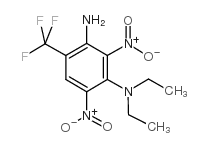Mechanism of xanthine oxidase catalyzed biotransformation of HMX under anaerobic conditions.
Bharat Bhushan, Louise Paquet, Annamaria Halasz, Jim C Spain, Jalal Hawari
文献索引:Biochem. Biophys. Res. Commun. 306(2) , 509-15, (2003)
全文:HTML全文
摘要
Enzyme catalyzed biotransformation of the energetic chemical octahydro-1,3,5,7-tetranitro-1,3,5,7-tetrazocine (HMX) is not known. The present study describes a xanthine oxidase (XO) catalyzed biotransformation of HMX to provide insight into the biodegradation pathway of this energetic chemical. The rates of biotransformation under aerobic and anaerobic conditions were 1.6+/-0.2 and 10.5+/-0.9 nmolh(-1)mgprotein(-1), respectively, indicating that anaerobic conditions favored the reaction. The biotransformation rate was about 6-fold higher using NADH as an electron-donor compared to xanthine. During the course of reaction, the products obtained were nitrite (NO(2)(-)), methylenedinitramine (MDNA), 4-nitro-2,4-diazabutanal (NDAB), formaldehyde (HCHO), nitrous oxide (N(2)O), formic acid (HCOOH), and ammonium (NH(4)(+)). The product distribution gave carbon and nitrogen mass-balances of 91% and 88%, respectively. A comparative study with native-, deflavo-, and desulfo-XO and the site-specific inhibition studies showed that HMX biotransformation occurred at the FAD-site of XO. Nitrite stoichiometry revealed that an initial single N-denitration step was sufficient for the spontaneous decomposition of HMX.
相关化合物
| 结构式 | 名称/CAS号 | 分子式 | 全部文献 |
|---|---|---|---|
 |
敌乐胺
CAS:29091-05-2 |
C11H13F3N4O4 |
|
Insights into the formation and degradation mechanisms of me...
2002-02-15 [Environ. Sci. Technol. 36(4) , 633-8, (2002)] |
|
High-performance liquid chromatographic determination of din...
[J. Chromatogr. A. 585(1) , 164-7, (1991)] |
|
Persistence of dinitramine and trifluralin in Nova Scotia, C...
1980-02-01 [Bull. Environ. Contam. Toxicol. 24(2) , 238-43, (1980)] |
|
Carry-over of dinitramine, triallate, and trifluralin to the...
1982-10-01 [Bull. Environ. Contam. Toxicol. 29(4) , 483-6, (1982)] |